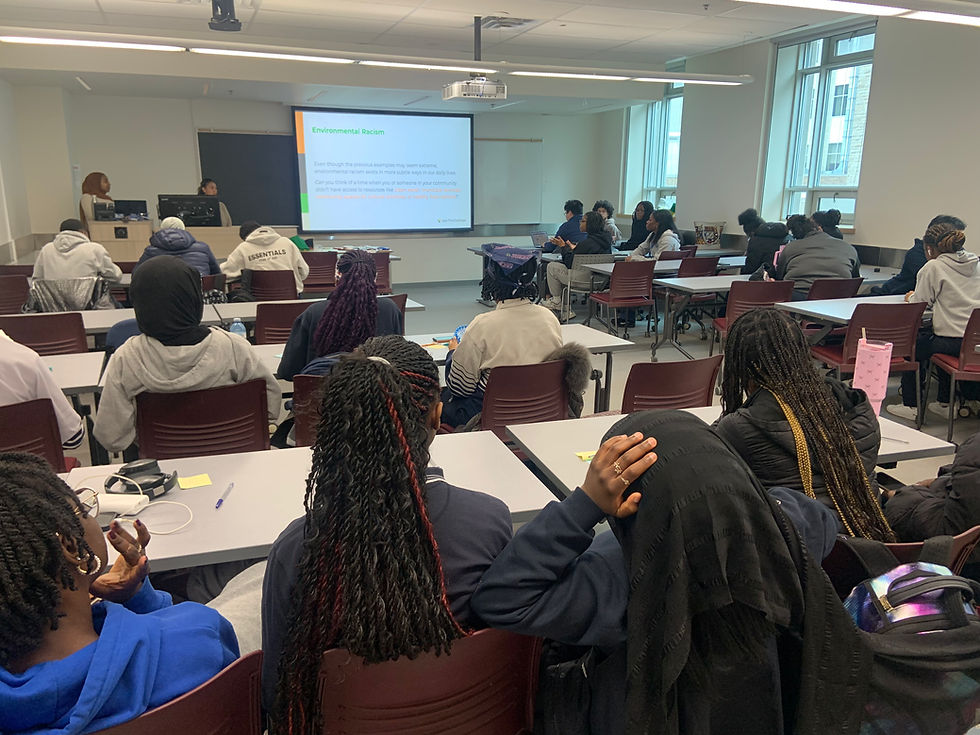April Showers Bring May STEM Flowers: Up4 at John Polanyi Collegiate, May 2023.
- Eliot Rossi
- Jun 12, 2023
- 3 min read

The cornerstone of our community work at Up4 The Challenge is the STEM Design Experience workshop, where students from grades 7 to 12 have the opportunity to tackle design challenges in their own lives, build rudimentary, “low-fidelity” prototypes of their unique solutions to these problems, and identify the STEM concepts and practices used in each solution.
In the second half of May, facilitators from Up4 The Challenge brought the workshop to Grade 9/10 and 12 science classes at John Polanyi Collegiate Institute in Toronto, Ontario. Each class was divided into groups of about four students. We asked the groups to consider the effects of climate change on their daily lives; namely, the extreme weather that has become increasingly frequent in the Greater Toronto Area; and to respond to those challenges in an innovative way, using empathic design thinking.
Empathy is key to successful design thinking. In order to effectively shrink the magnitude of human-caused climate change, we have to consider whether we have access to the right choices and resources. Do we have tools to reduce our environmental impact, or do the provided tools fall short? What barriers exist to our use of those tools? Outside of my work with Up4 The Challenge, I sometimes paint sets for movies and TV shows, jobs that are frequently located outside of Toronto, beyond the reach of reliable public transportation. As such, I find myself relying on driving to work, asking for rides from my co-workers, or paying for rideshares, even if my job site is right next to a GO Transit station. I need to drive to work, because surprisingly, there often aren’t viable alternatives.
Transportation was certainly a present concern for John Polanyi Collegiate Institute students. They came up with a diversity of solutions to transportation issues, from designing pothole-proof roads to cut down on construction-based carbon emissions, to the systematic expansion of high-quality rapid transit to all corners of the GTA. One group even suggested a network of zip-lines to move commuters and students across the city. Other students’ concerns dovetailed with their own socio-economic concerns, such as finding ways to transition tall apartment buildings from using diesel fuel to renewables to generate backup power during blackouts, and to reduce load on electrical grids to reduce the frequency of those blackouts; or designing a set of clothing that could be worn in all weather conditions, would be comfortable, good-looking, affordable, and durable, to cut down on carbon-intensive manufacturing processes used by the fast-fashion industry.
The groups also consulted with community members to inform the direction of their design process, including friends, family, and Up4 The Challenge’s special guest, Women of Renewable Industries and Sustainable Energy Ontario chair Alexis Dunphy. Combining what they learned from the community with their own brainstorming, they built low-fidelity prototypes of their solutions; simple, three-dimensional physical models made of common craft-store materials, such as construction paper, popsicle sticks and pipe cleaners.
The following week, we brought the grade 12s to the Evergreen Brickworks to continue their design process. Evergreen’s April Nicolle led our group on a tour of the Brick Works’ natural spaces, and used a combination of her science knowledge and personal experience to discuss the innovative features of Brick Works park. Unlike during the days of industrial activity at the Brick Works, Evergreen’s stormwater management strategy relies on natural wetlands that conveniently also provide a home for local wildlife, like the various turtle species that abounded on the day of our visit. The students were encouraged to incorporate lessons learned from nature into the next iteration of their design, and to assess the degree of impact and effort that each potential solution from their brainstorm would involve. The last activity of the day was to draw “storyboards'' that illustrated how life would be changed or improved by the implementation of each group’s solution. As a visual aid, I brought in my companion map to Alana Wilcox and Jason McBride’s excellent uTOpia book series, which itself assesses the needs of Toronto and the barriers to their fulfillment. Designed by Andrew Alfred-Duggan, the map acts as a prototype that demonstrates many outside-the-box ways to improve Toronto’s urban environment and climate resilience, from massively expanded TTC service, to a network of elevated bike paths, to the conversion of some streets to parks and canals, and even the construction of new islands in Lake Ontario.
As of the time of writing, we have one remaining week with the JPCI grade 12s. The rest of the Up4 The Challenge team and I eagerly anticipate the new ideas and further refinements the students will bring to their solutions in our next session.







Comments